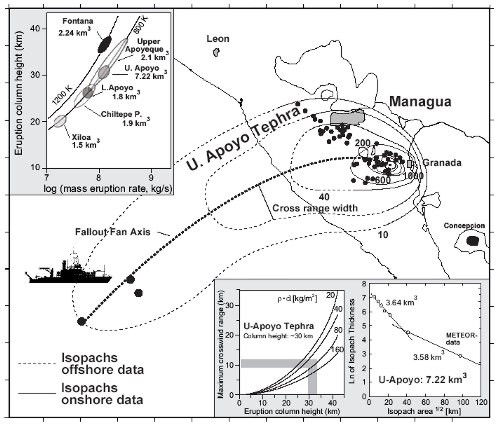 Web Content Anzeige Web Content Anzeige
Overview Theme C4
The general objective of the C-projects in SFB 574 is to trace the evolution of volatiles from metamorphic reactions in the subducted slab through metasomatism and melting in the mantle wedge and differentiation of ascending magmas to degassing at the surface and introduction into the atmosphere. Project C4 is concerned with the final part of this pathway. Major objectives of project C4 have been the assessment of volcanic hazards at the volcanoes studied in Central America, determining of magma fluxes at those volcanoes and the fate of the volatile species during magmatic evolution and explosive eruption particularly of evolved arc magmas. After addressing those questions successful to Central America, a more oceanic island arc, we will continue to pursue these objectives in Chile a continental arc with minor adaptations to the different geologic and logistic situation. The results of both different study areas will culminate in the end to an overall picture of magma and volatile fluxes in evolved magma systems of subduction zones. We summarized our results of phase 1 and 2 so far, within 6 major topics, described by the keywords: tephrostratigraphy, magma production rates, volatile fluxes, magma evolution, volcanic hazards and benefits for other topics. So far, basic study has been tephrostratigraphy complemented by distribution and grain size data in whole Central America and the offshore region. Using this data base we have determined erupted magma masses and stratospheric eruption column heights for most eruptions. Applying this along the arc facilitate the calculation and comparison of minimum magma fluxes in whole Central America. Bulk and microchemical analyses of matrix and inclusion glasses and phenocrysts allow to interpret magma evolution by fractional crystallization and magma mixing. Also analysed volatiles allow to determine volatile fluxes of evolved magma systems along the Central American Volcanic Arc (CAVA). All those studies in the end help to understand better the evolution of highly explosive eruptions and their implications for climate and therefore are also important for evaluating volcanic hazards in regions of subduction zones.
Fig. 1: Illustration of the determination of eruption parameters using Upper Apoyo Tephra as example. Isopach and similarly shaped isopleth maps constructed from field data on land and off-shore. Isopach thickness vs. area plots (lower right) yield erupted tephra volume which is converted into magma mass considering pore space and lithics content. Isopleth cross range width is used to determine column height from modelling results (bottom center). Similarly, column height is related to mass discharge rate (top left). |
 Events Events
Kieler Wissenschaftler fühlen den 'Puls der Erde' Wie funktioniert die Recyclingmaschine der Erde?Nach elf Jahren endet der Kieler Sonderforschungsbereich 574 zu Subduktionszonen Final colloquium of SFB 574 Teilprojekt ÖffentlichkeitsarbeitMEERESFORSCHUNG FÜR MICH UND DICH |
|
©SFB574 // Wischhofstrasse 1-3 // D-24148 Kiel // T. +49 (0)431 600 1413 // elange [AT] geomar.de






